11 Ways To Upgrade Your Homemade Lo Mein
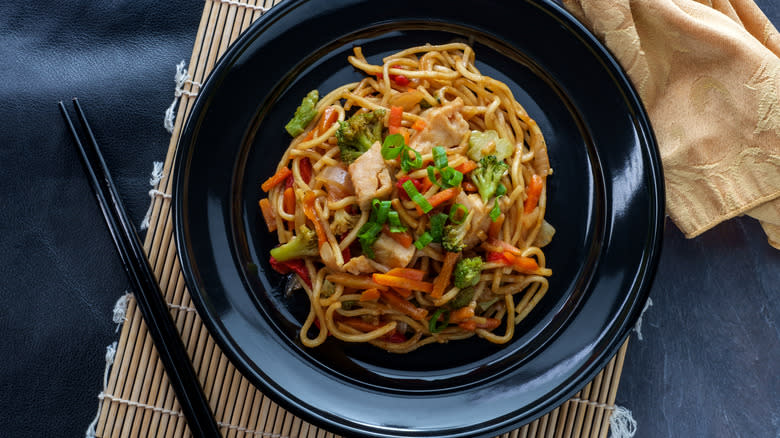
Lo mein is a quintessential takeout favorite. It consists of savory noodles, vegetables, and meat in a sauce rich with sesame oil, soy, and oyster sauce. It delivers umami deliciousness in every bite. Stir-fried to caramelize the noodles while keeping the veggies crisp-tender, lo mein comes from the Chinese "lao mian," meaning "stirred noodles." However, the Western version of the dish is a bit saucier than the traditional Northern Chinese delicacy.
We love to make takeout classics at home; it saves money, and homemade versions are always better for you. Controlling the amount of fat and sodium in the dish is only the beginning: Making your own lo mein lets you customize the spice level, which vegetables you like, and the quality and quantity of every ingredient. A fact about lo mein is that it's quick and easy to prepare, making it ideal for busy weeknights. If you're ready to up your game when it comes to lo mein, read on for ways to make it yourself in a way that tastes even better than takeout.
Read more: 16 Little-Known Facts About Salt
Add Extra Veggies
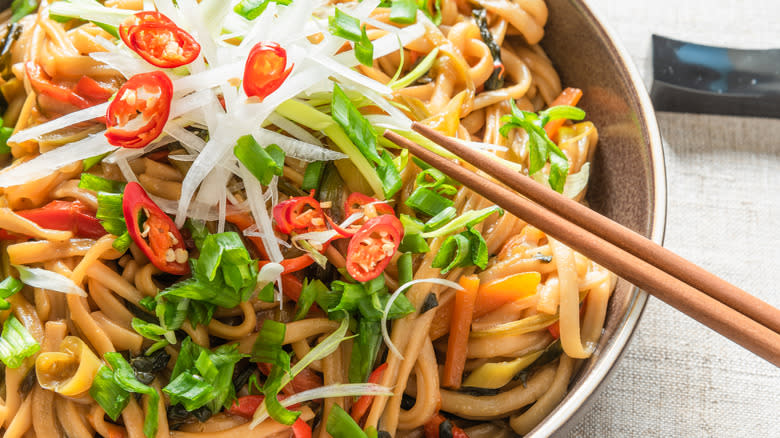
Whether you're fully vegan or vegetarian, or you want to reduce your meat consumption, vegetable lo mein is an excellent choice. With the flavors and mouthfeel from the noodles and the sauce, meat isn't the star of lo mein anyway, so we say pile on the veggies for plenty of fiber, vitamins, and minerals. You can go wild with any vegetables you love: broccoli, peppers, bok choy, mushrooms, carrots, and celery spring to mind. Protein lovers could make our 15-Minute Veggie Lo Mein recipe, which adds edamame for a perfect balance of carbs, fiber, and protein.
In addition to fresh veggies, don't forget to shop for canned or frozen Asian delicacies like bamboo shoots, water chestnuts, and baby corn. They add texture and nutrients, and baby corn is so darn cute we can't resist tossing it in whenever we can. If you crave lo mein with meat, that's fine — adding extra veggies is always appropriate.
Make It Thai-Style With Peanut Sauce
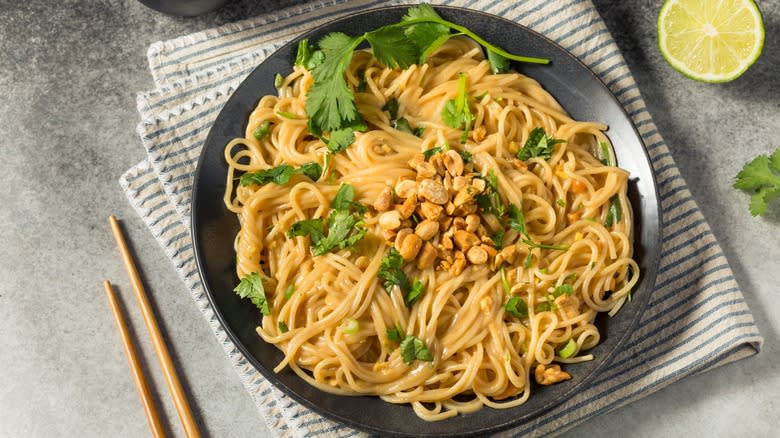
Try making lo mein with a Thai twist for an irresistible fusion dish. Thai peanut sauce is nutty, spicy, and slightly sweet, coming together in a flash. The ingredients are simple: It takes a few pantry staples like peanut butter, sesame oil, rice wine vinegar, Sriracha, and spices. Whisked together with a couple of tablespoons of water to thin it out, the sauce coats the noodles perfectly. As to the rest of the dish, adding vegetables and protein is a must for a balanced meal. What you add is up to personal preference and what's on hand, but heartier veggies generally work better with peanut sauce because they can stand up to the bold flavors while adding texture and freshness to the dish. We love any combination of broccoli, snap peas, carrots, cabbage, and bell peppers.
Tofu is an ideal vegetarian protein option because it offers a hearty texture that stands up to (and absorbs) the peanut sauce. Chicken, shrimp, or beef are all excellent with Thai peanut sauce, so meat eaters, take your pick. A garnish of peanuts over the top adds more protein and fiber while lending visual appeal and a satisfying crunch.
Use Your Favorite Noodles
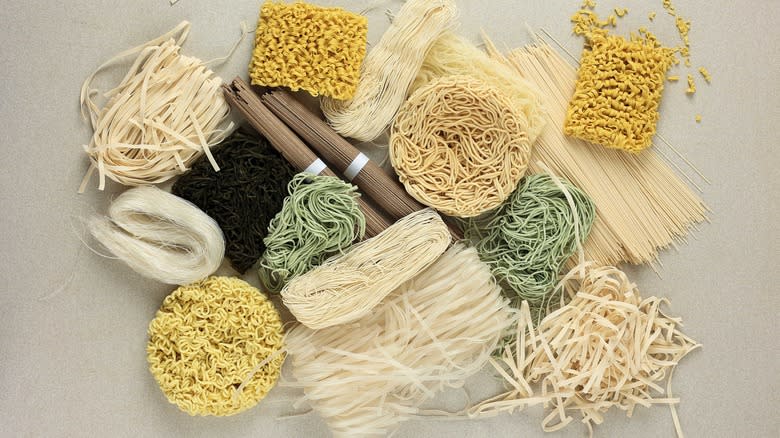
Traditional lo mein is made with fresh, wheat-based egg noodles cooked briefly in boiling water before being tossed in a wok with sauce, vegetables, and meat to make the savory dish we all love. That said, fresh lo mein noodles aren't easy to find in the States. While some grocery chains carry noodles labeled "lo mein egg noodles," they can be hard to get depending on where you live.
Luckily, cooking at home means you can take liberties with different types of Asian noodles, whether because of allergies, dietary preferences, or just because you really want lo mein but don't feel like shopping. Soba noodles are gluten-free, ramen noodles often lurk in the pantry, and udon noodles are Japan's ultimate comfort food — if that's not optimal for lo mein, we're not sure what is. We're not above using spaghetti for lo mein, either. Using different noodles might feel like cheating, but we're confident that the finished dish will taste just as good, and delicious food is its own reward.
Protein Makes It A Meal
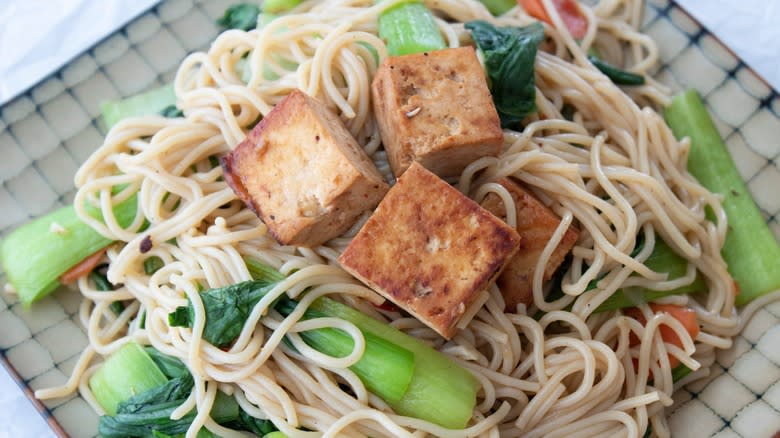
Many people are concerned about eating too much meat for health or environmental reasons. This makes vegetable lo mein a no-brainer for a fabulous quick meal that minimizes effects on the planet and your health, right? Well, yes and no. There's no doubt that the more vegetables you consume, the better, but vegetable lo mein can still be improved by a protein source — and that doesn't necessarily mean meat.
Protein is essential to your body in many ways: It helps build and repair tissue, supports your immune system, keeps you full longer so you don't snack mindlessly, helps build muscle, adds flavor and texture, and adds different nutrients to your meal. For vegetarian protein sources, tofu, seitan, tempeh, edamame, chickpeas, lentils, and nutritional yeast are all nourishing options. Of course, if you're willing to eat it, meat is another easy way to add protein to lo mein. No matter your choice, a protein source makes lo mein a filling and balanced meal.
Korean BBQ Kicks Lo Mein Into High Gear
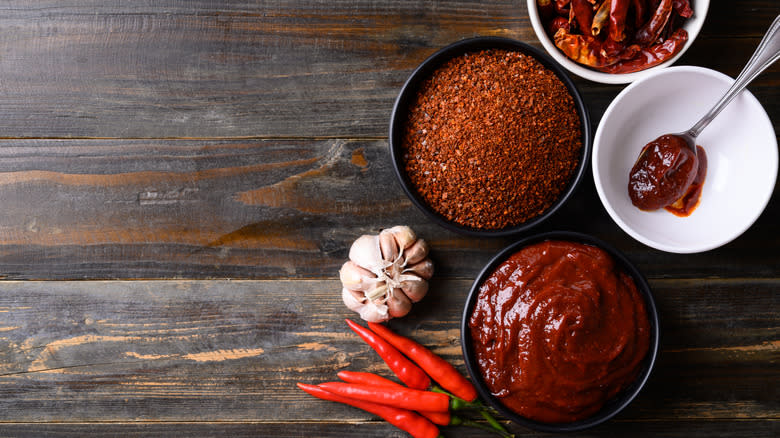
The flavors of Korean barbecue usually bring beef bulgogi to mind — and indeed, the thinly sliced beef in sauce spicy with gochujang and sweet with Asian pears eaten family style is absolutely delicious. Combining bulgogi with lo mein is an incredible fusion of flavors that can unleash your culinary creativity. If you're not in the mood for beef, you can use any protein you like; bulgogi can be made with chicken, pork, or lamb, and if you want to make tofu bulgogi, we say go for it.
Make the sauce according to your preferences and adjust the amounts of gochujang, soy, and brown sugar depending on how spicy you like it. Bulgogi is often more savory than spicy since it's considered a family meal, but the chef always knows how much heat is enough, right? If you don't have Asian pears around, using any pear or even an apple is fine — the sweet fruitiness is what's important. We love bok choy, mushrooms, broccoli, or cabbage with bulgogi lo mein, but use the vegetables you love to add vitamins, color, and texture and enjoy the perfect fusion lo mein.
Sweet And Spicy Is Super
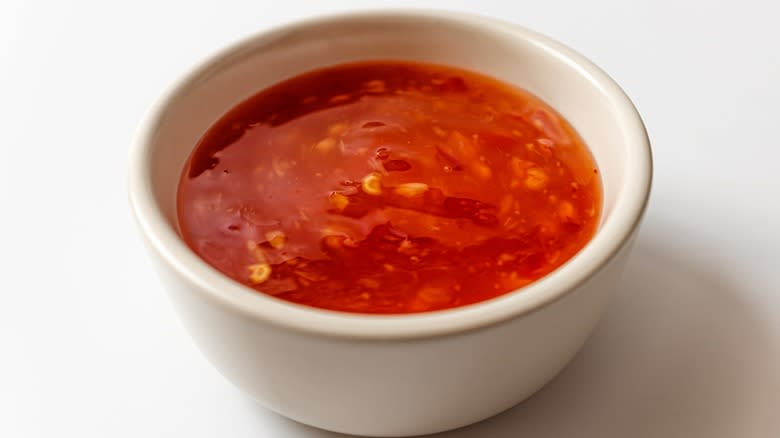
Combining sugar and spice has always been nice, whether it's Mexican hot chocolate that amps the flavor with chili powder, hot pepper jelly with a kick of jalapeño, or Mike's Hot Honey, which started life as a pizza add-on. Something about the combination always leaves us wanting more, whether it's because the sweetness tones down the heat or the spice enhances the sweetness. Bottom line: It's an irresistible combination.
With that in mind, making the sauce for lo mein with sweet heat makes sense. Bottled General Tso's sauce is readily available and combines sweet, spicy, and sour, which makes it an ideal match for chicken lo mein. Gochujang is a Korean sauce made from fermented soybeans, rice, and red peppers, though depending on the brand, it may be fiery or spicy-sweet. Korean chefs often add sugar, water, or vinegar to alter its flavor, so customizing it to your tastes is easy. Making sweet chili sauce yourself is always an option, using ingredients you likely have in your kitchen. If you crave sweet and spicy goodness, get creative and turn lo mein into a "swicy" treat you'll make on repeat.
Customize Spices And Flavors
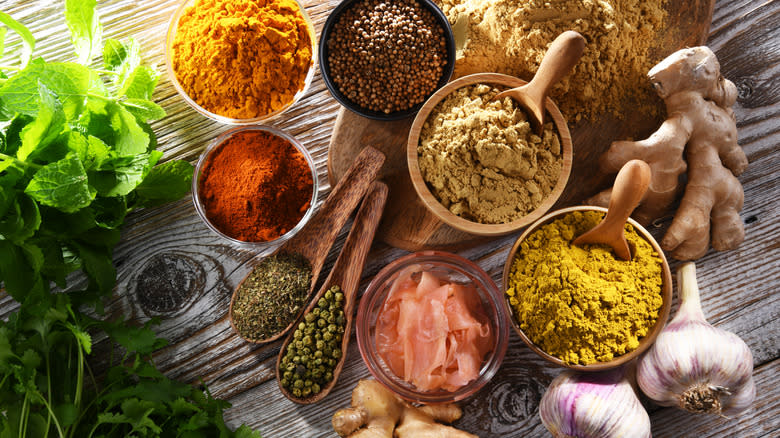
Takeout lo mein has a savory sauce generally consisting of sesame oil, soy sauce, and oyster sauce. It tastes good, but we can elevate the flavors in our kitchens into something unique. Those who are not fans of spicy food can use fresh garlic, ginger, coconut milk, or lime juice to add flavor. Fish sauce adds depth and that umami taste lo mein is known for. Or, you could mix up some five spice powder, a uniquely warm and slightly spicy Sichuan blend of anise, cinnamon, cloves, fennel, and Sichuan peppercorns.
Prepared condiments like harissa, Sriracha, or teriyaki sauce are simple additions to lo mein when you want a meal fast. If you want some heat, chili flakes sprinkled on top deliver, or you can customize the spice level with fresh or dried chili peppers. We love using dried chiles because they have a longer shelf life and a more complex flavor and texture, but there are so many types of chiles that everyone will have a favorite. Dried chiles may be rehydrated with boiling water and puréed to make a sauce or left whole for presentation (so anyone who doesn't like them can pick them out!), while fresh chiles can add crunch and spice. Whichever way you customize your flavors, your lo mein game will improve.
Curry Sauce Adds Incredible Flavor
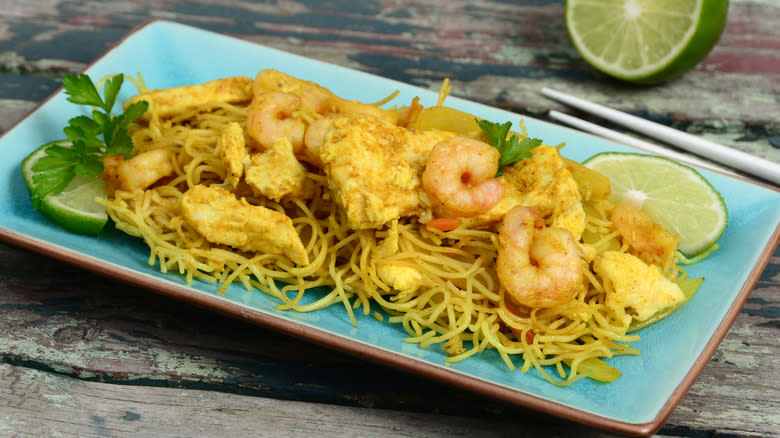
Sometimes, it's fun to reimagine dishes using elements of another cuisine. Think of it as a "best of both worlds" scenario, and we think that lo mein with an Indian twist makes for a culinary delight. Curries are easy to make and adaptable, whether you want to use meat or make a vegetarian meal. Cauliflower or chickpea curry is nutritious and tasty, and chicken curry is always delightful.
Coconut milk gives curry its creamy richness, and you'll want garlic, ginger, and curry powder for flavor, not to mention that gorgeous yellow color. Remember, curry powder varies in intensity and spiciness; don't assume all curries are spicy (though you can always make it spicier with chili flakes). Finishing off a curry with a sprinkle of garam masala highlights the warmth of cinnamon and cloves, though again, garam masala varies widely depending on the brand. Making your own blend isn't hard to do and ensures that the balance of warmth and spice is right for you. Get creative with your curry, combine it with lo mein noodles, and prepare for a fusion dish you'll crave again and again.
Opt For Convenience
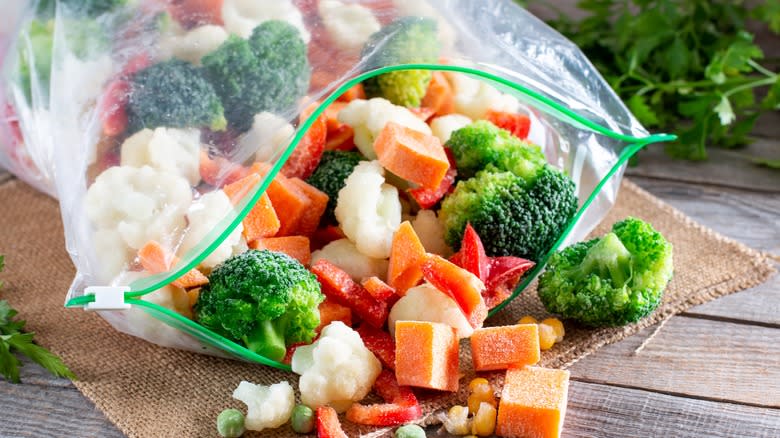
While cooking can be fun, everyone has busy nights with hectic schedules. Whether you're working late or have evening activities, sometimes you need a meal that can be on the table fast. The good news is that doesn't mean you have to order takeout or make boxed mac and cheese. Lo mein is a dish that comes together quickly even when using fresh veggies and stir-fried meat, but it can be lightning-quick if needed. Using leftovers serves a dual purpose: It clears out your fridge and it eliminates prep work. The broccoli you didn't finish one night can be tossed right in. Leftover steak can be sliced and added to lo mein.
There are also shortcuts even if your fridge isn't groaning with Tupperware. Long afternoon getting groceries? Add a grocery store rotisserie chicken to your shopping list, and you can shred some for lo mein. If the idea of chopping fresh veggies is too much after one of those days, a bag of frozen vegetables is not only a convenient choice, it's a healthy one — frozen vegetables are harvested at peak ripeness and remain that way, unlike those green beans that are languishing in the produce drawer. Don't let a busy schedule derail plans for a succulent lo mein; these tricks ensure dinner comes together in a snap.
Miso Takes Lo Mein To The Next Level
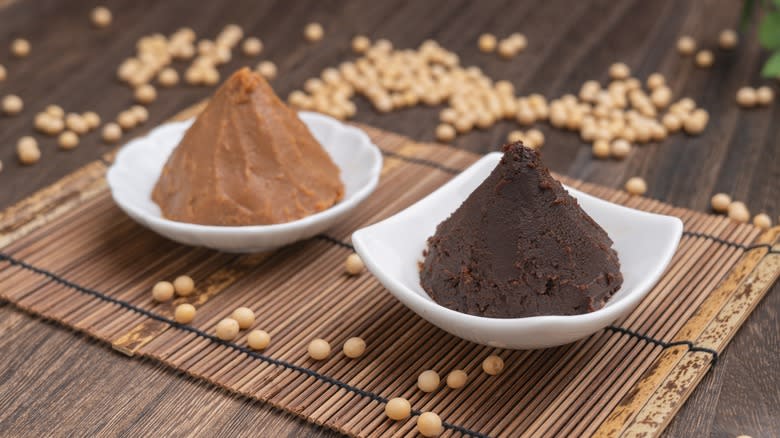
Miso glazed eggplant is a popular appetizer or entrée in Japan, and it's no wonder — roasted eggplant caramelized on the grill or in the oven with miso, honey, soy sauce, and mirin (a type of sweet rice wine) is perfectly balanced with sweet, salty, sour, and umami notes. The sugars in the glaze form a crust as the eggplant cooks, leaving it tender on the inside, and a sprinkling of sesame seeds on top adds extra crunch. Miso, a fermented soybean paste, is hard to pin down because its flavor varies wildly depending on its exact ingredients and how long it was allowed to ferment. Still, white miso is generally milder than red, which has a proper punch to it.
Miso glaze is a natural addition to lo mein; the flavors mimic takeout lo mein with an elevated kick, as though a celebrated chef decided to put their spin on the humble dish. If you love eggplant, we suggest glazing and grilling it in the traditional thick slabs, then julienning it into small strips to add to the lo mein noodles. Feel free to roast your favorite combination of veggies in the miso glaze if you prefer — we think carrots, zucchini, mushrooms, and cabbage would all go beautifully here. Make extra glaze for the noodles, toss everything together, and enjoy your fabulous creation.
Reimagine Takeout Classics
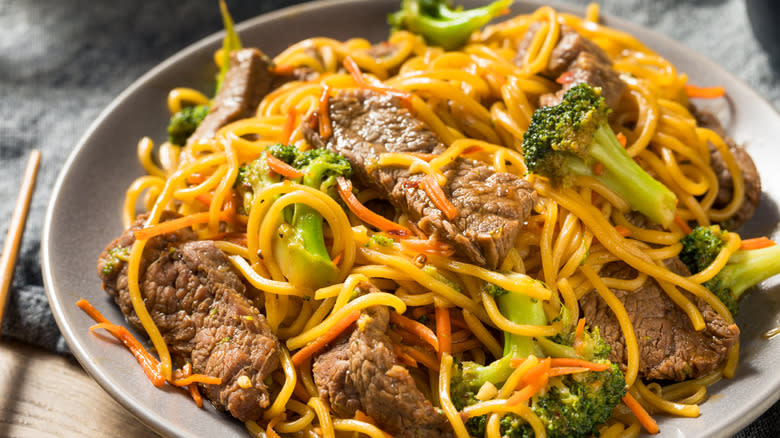
Takeout Chinese usually involves several entrées, while making dinner at home means just one. The good news is that cooking at home means you're free to get creative, so why not combine your favorite Chinese entrée with lo mein for the perfect fusion meal? No matter which option you choose, it's simply substituting different protein sources and veggies with noodles for your take on lo mein.
With its sweet and sour citrus sauce, orange chicken would be excellent with lo mein noodles. Adding vegetables like bell peppers, onions, snow peas, or green beans puts a nutritious spin on the dish since restaurants usually serve it without any veggies at all. Fans of beef and broccoli can combine it with lo mein noodles for a hearty, satisfying dish at any time. Love pork and cabbage dumplings? The gyoza flavors work perfectly with lo mein; no wrappers are required. Whatever your favorite takeout meal, a lo mein fusion will improve it.
Read the original article on Mashed.

